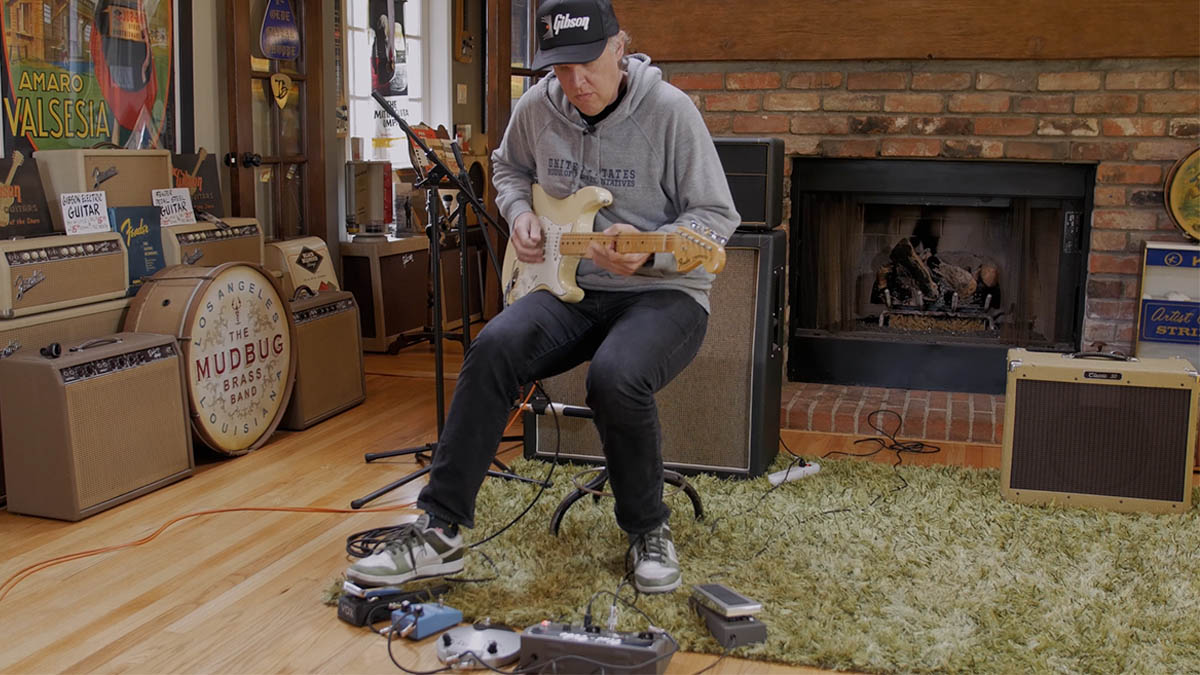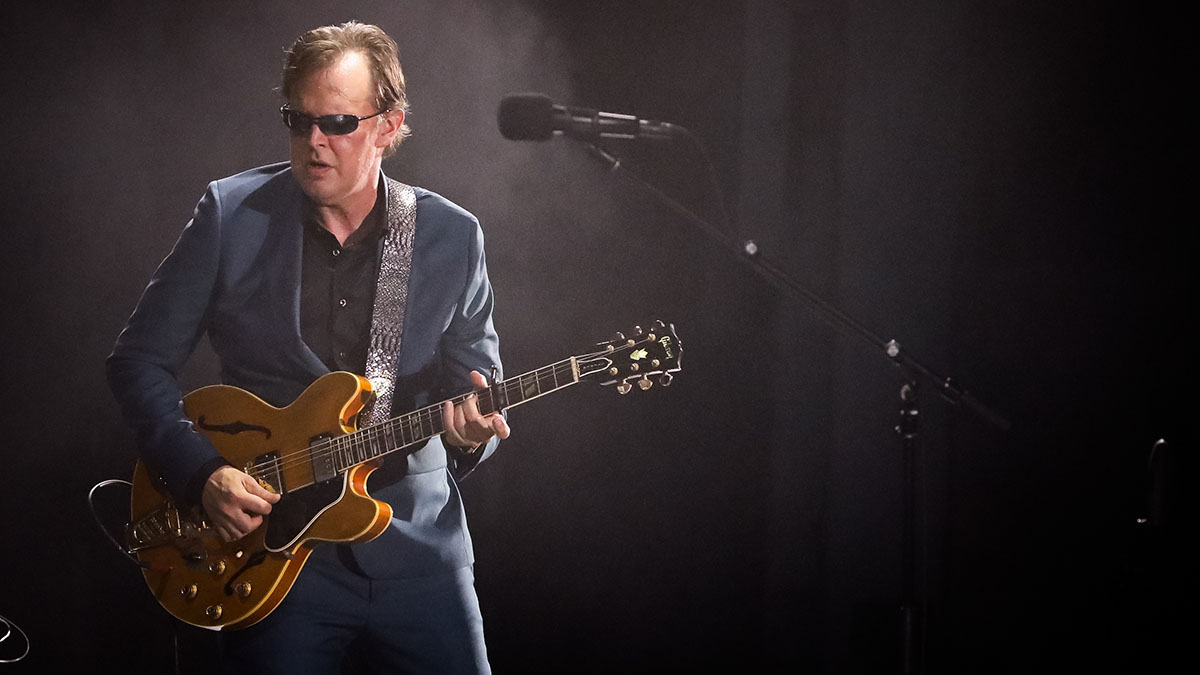“It’s noisy, it’s wild, and I’m by no means Jimi Hendrix, but we’ll get the gist”: Can Joe Bonamassa make a $1000 Band Of Gypsys rig sound like its vintage equivalent?
Watch JoBo pit two Hendrix-inspired rigs against each other from the comfort of his living room, one with a Squier Strat, a Peavey Classic and Dunlop pedals, the other all megabucks vintage gear

Joe Bonamassa might be the hardest working blues guitar player on the planet but he can still make time to satisfy his – and our – scientific curiosity, hosting the ultimate demo video from the comfort of his living room in Nerdville to find out whether a $1,000 rig could be as effective as an all-vintage rig for recreating Jimi Hendrix’s Band Of Gypsys electric guitar tones.
The video segment was shot for the online gear retail giant Reverb, and makes for fascinating viewing. Many of us have put tother a budget Hendrix rig, but the opportunity to hear it side by side with its genuine vintage equivalent is a rare treat. Doubly so when you’ve got Bonamassa playing them.
It wasn’t so long ago that JoBo was pointing the business end of a Dumble Overdrive Special in the general direction of his noisy neighbours. This vintage Band Of Gypsys rig could come in handy should that battle of wits escalate – Bonamassa broke out his 1969 Marshall Super Lead for this Hendrix test run, and it has 100-watts to take your head off.
“This is just a half-stack because, again, we are in my living room and I’d like to hear people post-this video,” he says. “This is a a 1969 Super Lead that I bought from the original owner who went and saw Hendrix at Woodstock, in 1969… I went to his house, and he had one of those Italian bottles of wine and was claiming that Eddie Van Halen stole all of his riffs – it was one of those crazy guitar stories but I got the amps.”

With a little help from guitar effects pedal guru Jeorge Tripps of Way Huge, Bonamassa’s Hendrix signal chain includes a ‘60s Vox wah pedal, a super Tycobrahe Octavia octave-fuzz pedal, an original 1979 Fuzz Face and a Uni-Vibe of similar vintage. Expensive, rare, unicorn stuff.
“Uni-Vibes, I would buy them as a kid for 400 bucks. Now, they probably add a zero,” says Bonamassa. The wah (which Reverb estimates at $1,500 to $4,500 on the used market) was borrowed.
The Fender Stratocaster is the model’s own, and it’s a peach. “This guitar, is a 1969, maple-cap, in Blonde,” says Bonamassa. “Hendrix’s was Olympic White, same damn thing, so this a $35,000 to $45,000 guitar.”
Get the MusicRadar Newsletter
Want all the hottest music and gear news, reviews, deals, features and more, direct to your inbox? Sign up here.
The budget version of the Hendrix rig has a more accessible signal chain. This is something you could easily set up on a pedalboard, with all pedals from the Jim Dunlop catalogue, all readily available from most guitar shops.
There is a Dunlop Jimi Hendrix signature Cry Baby, a Dunlop Octavio octave fuzz in the wedge-style enclosure, Dunlop Jimi Hendrix Fuzz Face (“which is basically the Woodstock one), and an MXR Uni-Vibe clone to round things out and provide that chewy sea-sick modulation that made it sound as though Hendrix was bending air, light and time itself. Accessible, sure, but heady, powerful stuff nonetheless.
There is no such thing as a bad guitar, or a bad amp, or a bad pedal... It’s how you drive it
Completing the rig we’ve got a Squier Strat, on loan from Bonamassa’s local guitar store, Norman’s Rare Guitars, and a Peavey Classic 30 tube combo – a “great amp,” and also more practical for today’s use, certainly more practical than the Super Lead, which Bonamassa clearly loves but is compelled to warn us against using them in most situations.
“You would be kicked out of the venue and told not to come back, and your career would be over if you used that,” he says, only half-joking. And with that it was time to play some licks and work the sound level meter. “It’s noisy, it’s wild, and I’m by no means Jimi Hendrix, but we’ll get the gist of it, so check it out.”

Which rig sounds better? Well, that’s almost besides the point. The real takeaway here is that with a budget rig, comprising items available anywhere, you could take it, mike it up and use it on record or in the studio.
“There is no such thing as a bad guitar, or a bad amp, or a bad pedal, or a bad cable,” says Bonamassa. “Well, maybe the cable’s bad. It doesn’t matter. It’s how you drive it.”
In other Bonamassa news, the Mayor of Nerdville has just announced Live At The Hollywood Bowl, with is available to preorder and will be released on all formats on 17 May via J&R Adventures. The album documents his career-high performance at the storied Los Angeles venue, on audio and video, with DVD and Blu-ray bundles available. Check out the first single from it, Twenty-Four Hour Blues, above.
Jonathan Horsley has been writing about guitars and guitar culture since 2005, playing them since 1990, and regularly contributes to MusicRadar, Total Guitar and Guitar World. He uses Jazz III nylon picks, 10s during the week, 9s at the weekend, and shamefully still struggles with rhythm figure one of Van Halen’s Panama.
“A fully playable electro-mechanical synth voice that tracks the pitch of your playing in real time”: Gamechanger Audio unveils the Motor Pedal – a real synth pedal with a “multi-modal gas pedal”
“Instead of labouring over a perfect recreation, we decided to make an expanded counterpart”: Chase Bliss teams up with Mike Piera for Analog Man collab based on the legendary King Of Tone











